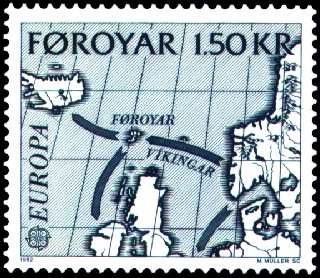1. Overview
Naddodd (NaddoðrNaddoðrNorse, Old, NaddoðurNaddoðurIcelandic, NaddoddurNaddoddurFaroese; fl. c. 9th century) was a Norse Viking often credited with the first discovery of Iceland. Born in Norway, he was also one of the earliest settlers of the Faroe Islands. His unplanned voyage from Norway to the Faroe Islands led him to drift off course to the east coast of Iceland, which he named "Snæland" (Snowland) due to a snowfall. Naddodd's account is primarily preserved in the medieval Icelandic manuscript Landnámabók, detailing his significant role in the era of Norse exploration and settlement.
2. Life
Naddodd's life encompassed his origins in Norway, his pioneering settlement in the Faroe Islands, and his accidental but historically significant discovery of Iceland, followed by details of his known family connections.
2.1. Birth and Background
Naddodd was born in Agder, a region in what is today southern Norway. He played a pioneering role in the Norse settlement of the Faroe Islands, becoming one of the earliest settlers there. This occurred after Grímur Kamban is recorded as the first to settle in the Faroe Islands around 825.
2.2. Discovery of Iceland
Naddodd's most notable contribution to history was his unplanned discovery of Iceland. While sailing from Norway back to the Faroe Islands, his ship became lost and drifted significantly off course. This drift eventually brought him to the east coast of an unknown land, near a bay and mountains where the modern Icelandic town of Reyðarfjörður is now located. Upon reaching the shore, Naddodd sought signs of human habitation; he climbed a mountain in search of smoke rising from fireplaces but observed no indications of human activity. Deciding to resume his journey to the Faroe Islands, Naddodd prepared to depart. As he was returning to his boat, a snowfall began, prompting him to name the newly discovered land "Snæland" (SnælandSnaelandNorse, Old), meaning "Snowland".

2.3. Family and Relations
Naddodd's family connections are noted in historical accounts. He is believed to be the probable father of Ann Naddodsdóttir, a Viking woman from Shetland. Furthermore, Naddodd held a distant kinship to other prominent figures in Norse history, including Erik the Red, who is known for discovering Greenland, and Erik's son, Leif Erikson, celebrated for his expeditions to North America.
3. Sources and Historical Context
The primary source of information regarding Naddodd's discovery of Iceland is the Landnámabók, a crucial medieval Icelandic manuscript. This book provides extensive details about the `landnám` (Icelandic: landnámlandnamIcelandic), meaning "land-taking" or "settlement", of Iceland by the Norsemen during the 9th and 10th centuries. Naddodd's voyage and discovery are situated within this broader era of Norse expansion and exploration, a period characterized by significant maritime journeys and the establishment of settlements across the North Atlantic. His account in the Landnámabók details how he inadvertently came across Iceland while navigating between Norway and the Faroe Islands, providing valuable insight into the exploratory nature of Viking seafaring.
4. Naming and Legacy
Naddodd's initial naming of the newly discovered land as "Snæland" (Snowland) was temporary. The island later became known as "Ísland" (ÍslandIslandIcelandic), meaning "Ice-land", a name given by the Norse explorer Hrafna-Flóki Vilgerðarson. Despite the subsequent renaming, Naddodd retains significant historical importance as the first Norse person whose arrival on the island of Iceland is formally documented. His accidental discovery marked an early, pivotal moment in the exploration of the North Atlantic and preceded the more systematic settlement efforts that followed.